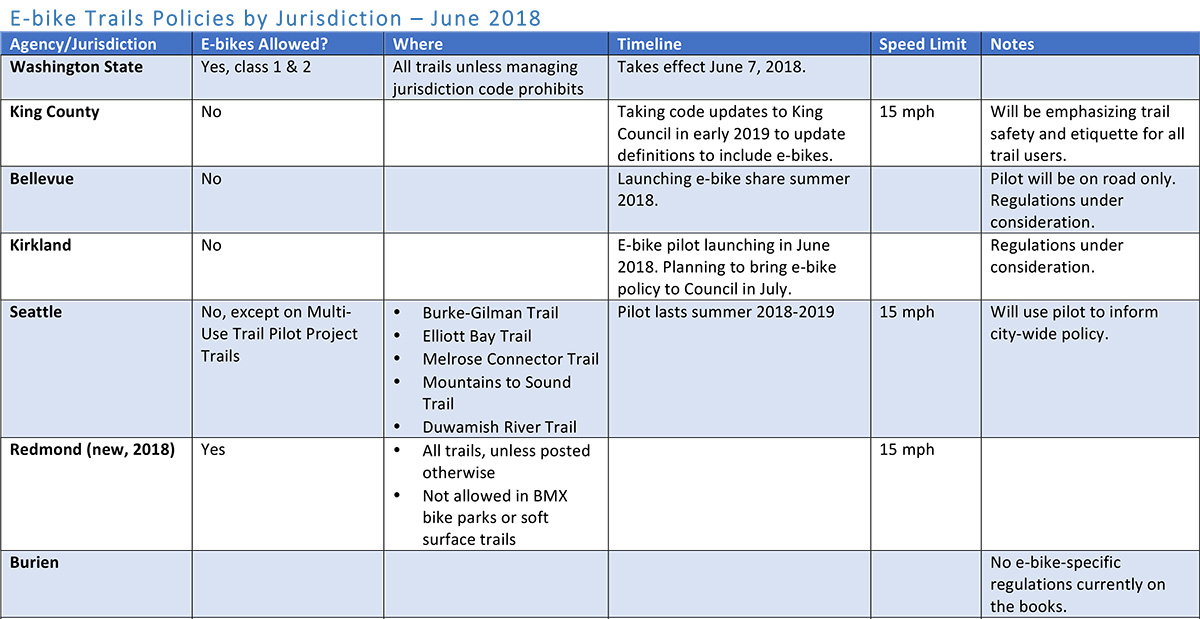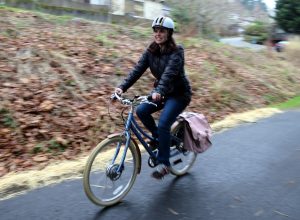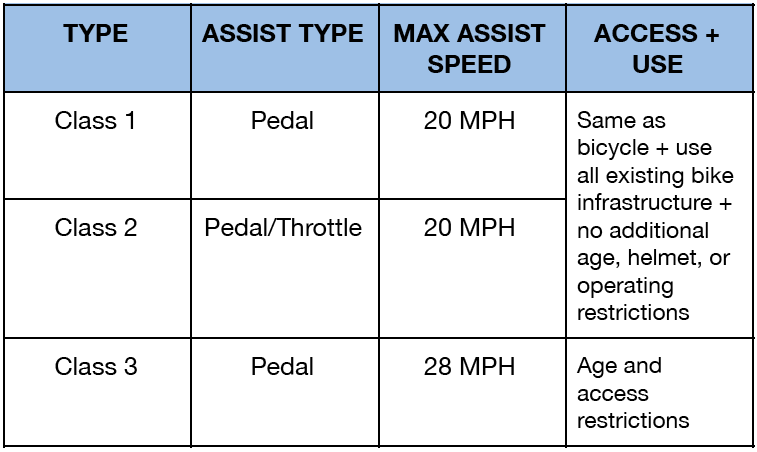From our friends at WABI Burien:
 (The following article is compiled from meeting notes and posts by Cascade Bicycle Club and Washington Bikes.)
(The following article is compiled from meeting notes and posts by Cascade Bicycle Club and Washington Bikes.)
 People who wouldn’t have considered riding a traditional bike are becoming electric bike (e-bike) riders. The electric pedal assist boost gives people the ability to flatten hills, travel longer distances or bike while carrying groceries or a child. E-bikes provide people new opportunities to enjoy the benefits of riding a bicycle. The growing availability and improved technology of electric-assist bicycles is reflected in the demand as e-bike sales are up more than 450% since 2013.
People who wouldn’t have considered riding a traditional bike are becoming electric bike (e-bike) riders. The electric pedal assist boost gives people the ability to flatten hills, travel longer distances or bike while carrying groceries or a child. E-bikes provide people new opportunities to enjoy the benefits of riding a bicycle. The growing availability and improved technology of electric-assist bicycles is reflected in the demand as e-bike sales are up more than 450% since 2013.
 Due to the excitement and demand around e-bikes, in early 2018 the Washington State Legislature passed SB 6434 which establishes a legal framework consistent with national standards and gives the e-bike industry certainty in the Washington market. The new law also provides users with a clearer understanding of where they can and cannot be on bikeways, trails and streets while ensuring that jurisdictions and agencies have the tools for enforcement and management of e-bikes on our streets and trails.
Due to the excitement and demand around e-bikes, in early 2018 the Washington State Legislature passed SB 6434 which establishes a legal framework consistent with national standards and gives the e-bike industry certainty in the Washington market. The new law also provides users with a clearer understanding of where they can and cannot be on bikeways, trails and streets while ensuring that jurisdictions and agencies have the tools for enforcement and management of e-bikes on our streets and trails.
Do you ride an e-bike in Burien?
Here’s what you need to know (before reading all the nitty gritty below).WABI-ists Maureen Hoffmann and Rob Gala met with City of Burien Director of Public Works Maiya Andrews, and PaRCS Director Steve Roemer, to ask about the presence of specific e-bike regulations here in Burien. Their response:“If your city doesn’t have specific laws on the books, the default is that Class 1 and Class 2 e-bikes can go everywhere traditional bikes can.â€
Therefore, within the City of Burien, Class 1 and 2 e-bikes may be used anywhere that a non-electric-assist bike may be used, subject to the same statewide laws… and of course, courtesy and safety.“There are NO e-bike-specific regulations in Burien.â€
What about e-bikes on the regional trails nearby?
Ahh. That’s a far more complicated question. Each city may or may not have its own regulations regarding the use of e-bikes, where they may travel and their allowed speeds. Complicating things further is the fact that some of the long, regional trails pass through multiple jurisdictions! This, currently, puts the burden on cyclists to know when a trail is in one city or another. (Oh! You just crossed into Renton… Now you just crossed into Bellevue…) Representatives from jurisdictions in King County have been meeting to compare notes about the use of e-bikes There are efforts underway to make regulations more uniform from one city to another; some of those efforts, however, are not scheduled until next year. King County Regional Trails has begun to compile the following chart. (As yet incomplete.) Click on the chart to enlarge it.
New E-bike law in Washington state took effect on June 7, 2018.
 What does the e-bike bill do?
What does the e-bike bill do?
Expands the definition of bicycle to include e-bikes; defines three distinct classes of e-bikes; updates rules around use of e-bikes
What is an e-bike?
A bicycle with two or three wheels, a saddle, fully operative pedals for human propulsion, and an electric motor with fewer than 750 watts of power.What are the three classes of e-bikes?
- Class 1: an e-bike that provides assistance only when the rider is pedaling and ceases to provide assistance when the bicycle reaches the speed of 20 mph
- Class 2: an e-bike where the motor may be used exclusively to propel the bicycle (throttle; without needing to pedal) and is not capable of providing assistance when the bicycle reaches the speed of 20 miles per hour
- Class 3: an e-bike where the motor provides assistance only when the rider is pedaling and ceases to provide assistance when the bicycle reaches the speed of 28 mph; also equipped with a speedometer

Where can I ride my e-bike?
- It depends on where you’re riding. If your city doesn’t have specific laws on the books, the default is that Class 1 and 2 e-bikes can go everywhere traditional bikes can.
- Class 3 e-bikes are restricted from shared-use pathways, as well as sidewalks. There is an allowance for Class 3 bikes on sidewalks in cases where there is no other safe alternative. Class 3 e-bikes are allowed on infrastructure that is within or adjacent to a highway (street).
- E-bikes cannot be ridden on a trail that is designated as non-motorized and that has a natural surface made by clearing and grading the native soil with no added surfacing materials. This provision in the legislation was amended to help improve interactions with other types of users on soft-surface single track trails. Exceptions may be made by a local authority or agency of this state that has jurisdiction over a particular trail.
Are e-bikes allowed on sidewalks?
- Class 1 and 2 e-bikes are treated as traditional bikes, which means they are allowed on sidewalks, subject to local laws that restrict bicycle riding on sidewalks.
- Class 3 e-bikes are prohibited on sidewalks except when there is no other safe option for the bikes to travel (for example on a bridge without a trail or other safe place to bike).
How fast do e-bikes travel compared to traditional bikes?
- The top assisted speeds of 20 mph and 28 mph can be deceiving. E-bikes typically resemble traditional bikes in function and average speed. Studies suggest a difference of 0-5 mph between a traditional bike and e-bike.
- It’s important to note that like motor vehicles, most people biking are not typically traveling at top speed at all times. This is the same for e-bikes.
Why restrict an e-bike’s power output to 750 watts?
The maximum of 750 watts aligns with federal consumer protection regulations. If the wattage is higher than 750, it is no longer classified as a bike, but instead as a motor vehicle for the purpose of consumer protection. Above 750 watts it is subject to more rules, including licensure and registration.What do e-bike manufacturers and retailers have to do because of this new law?
Manufacturers and retailers are required to permanently affix a label (in a prominent location) printed in arial font and at least nine-point type that contains the classification number, top assisted speed, and motor wattage.When did the legislation become law?
The law was enacted June 7, 2018, with the requirement to label new e-bikes on July 1, 2018.I owned an e-bike prior to the 2018 legislation becoming a law; what happens to my e-bike?
E-bikes purchased prior to the bill becoming law are not subject to the new requirements in the e-bike law update.Frequently Asked Questions
Cascade Bicycle Club published Frequently Asked Questions about Washington’s New E-bike LawTop photo of two cyclists and their bikes by Rad Power Bikes, Ballard, WA. Second photo, of a woman on an e-bike by Washington Bikes.]]>

